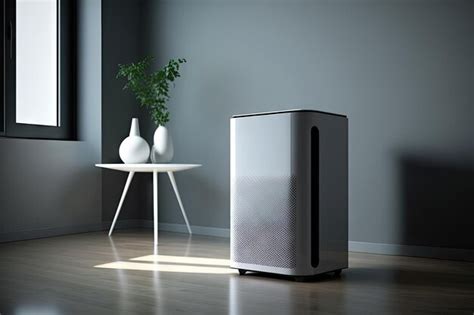In the era of mindful consumption and sleek living spaces, the clash between the necessity of air purifiers and the principles of minimalist design has become a topic of heated debate. Both sides present compelling arguments, making it crucial to delve into the nuances of this dichotomy to reach an informed decision.

The Benefits vs. Aesthetics Dilemma
Benefits of Air Purifiers:
- Improved Indoor Air Quality: Air purifiers effectively remove pollutants, allergens, and irritants from the air, creating a healthier indoor environment.
- Reduced Respiratory Health Risks: By removing harmful particles, air purifiers can help mitigate asthma, allergies, and other respiratory issues.
- Enhanced Sleep Quality: Cleaner air promotes restful sleep by reducing congestion and improving oxygen levels.
Aesthetic Considerations:
- Space Consumption: Traditional air purifiers can occupy significant floor space or wall space, potentially disrupting the minimalist aesthetic.
- Visual Clutter: Air purifiers with bulky designs or visible cords can create visual distractions and detract from the simplicity of a minimalist space.
Finding Harmony: Minimalist Air Purifier Innovations
Thankfully, advancements in design have paved the way for air purifiers that embrace the principles of minimalism. These innovative devices offer the benefits of clean air without compromising on style.
- Sleek and Compact Designs: Modern air purifiers feature compact and streamlined designs that blend seamlessly into any décor.
- Hidden Features: Air purifiers with hidden controls or integrated air inlets maintain a clean and uncluttered appearance.
- Use of Natural Materials: Devices crafted from natural materials like wood or ceramic add a touch of warmth and organic elegance to a minimalist space.
Tips for Choosing the Best Air Purifier for Minimalist Design
- Consider the Form Factor: Opt for air purifiers with a small footprint or wall-mounted options to minimize space consumption.
- Choose Discreet Designs: Select air purifiers with subdued colors, minimalist lines, or subtle patterns that complement your décor.
- Pay Attention to Filtration: Ensure the air purifier you choose effectively removes the pollutants and allergens relevant to your space.
- Embrace Smart Features: Consider smart air purifiers that can be controlled remotely or have air quality sensors, adding convenience without visual clutter.
The Future of Air Purifier Design in 2025
As technology evolves, we can anticipate even more innovative air purifier designs that prioritize both functionality and aesthetics. Here are some futuristic concepts to keep an eye on:
- Ultra-Compact Devices: Air purifiers the size of a book or smaller, effortlessly blending into any space.
- Wearable Air Purifiers: Personal air purifiers that can be worn around the neck or wrist, providing clean air on the go.
- Self-Cleaning Air Purifiers: Air purifiers that automatically clean their filters, eliminating the need for manual maintenance.
Conclusion
The debate between air purifiers and minimalist design is not a zero-sum game. With careful consideration and the latest design innovations, it is possible to enjoy the benefits of clean air without sacrificing the aesthetics of a minimalist space. By embracing sleek, discreet, and multi-functional air purifiers, you can create a harmonious environment that promotes both health and well-being. As we move towards 2025, the future holds exciting possibilities for air purifier designs that seamlessly integrate into our living spaces, enhancing both our air quality and our aesthetic sensibilities.
Frequently Asked Questions
-
How often should I change my air purifier filter?
Depending on the model and usage, air purifier filters typically need to be replaced every 3-6 months. -
Can air purifiers be harmful to my health?
Well-maintained air purifiers with HEPA filters are generally considered safe for health. However, some older or poorly maintained air purifiers may release harmful ozone. -
What type of air purifier is best for my space?
The best air purifier for your space depends on the size of your room, the level of pollution, and your specific needs. Consider factors like CADR (Clean Air Delivery Rate) and the types of pollutants you want to remove.
Useful Tables
| Table 1: Air Purifier Benefits |
|—|—|
| Improved Indoor Air Quality | Reduced Respiratory Health Risks | Enhanced Sleep Quality |
| Removal of Pollutants and Allergens | Mitigation of Asthma, Allergies | Promotion of Restful Sleep |
| Table 2: Air Purifier Design Considerations |
|—|—|
| Space Consumption | Visual Clutter | Hidden Features |
| Compact and Streamlined Designs | Natural Materials | Discreet Colors and Patterns |
| Table 3: Air Purifier Technology Trends |
|—|—|
| Ultra-Compact Devices | Wearable Air Purifiers | Self-Cleaning Air Purifiers |
| Size of a Book | Personal Air Purification | Automated Filter Cleaning |
| Table 4: Air Purifier Maintenance Tips |
|—|—|
| Regular Filter Changes | Proper Placement | Avoid Overuse |
| Follow Manufacturer’s Instructions | Ensure Adequate Airflow | Clean Surrounding Area |





















